ACCT20073: Company Accounting, Assessment Task 2 Part A Analysis
VerifiedAdded on 2022/10/11
|7
|1412
|8
Homework Assignment
AI Summary
This assignment delves into key aspects of company accounting, focusing on fair value measurement and impairment testing of assets. The student's work addresses the application of IFRS 13 and AASB standards, specifically examining how companies should determine fair value, considering market participants and relevant factors. The assignment further explores depreciation methods, contrasting the historical cost model with fair value models and providing justifications for managerial preferences. Additionally, it covers impairment testing, explaining how companies assess and identify potential impairments, including the concept of cash-generating units and their application in determining asset values. The analysis includes examples related to the Saferide Bus Company, illustrating how cash flows are evaluated to determine impairment and the challenges of isolating cash flows for individual assets.
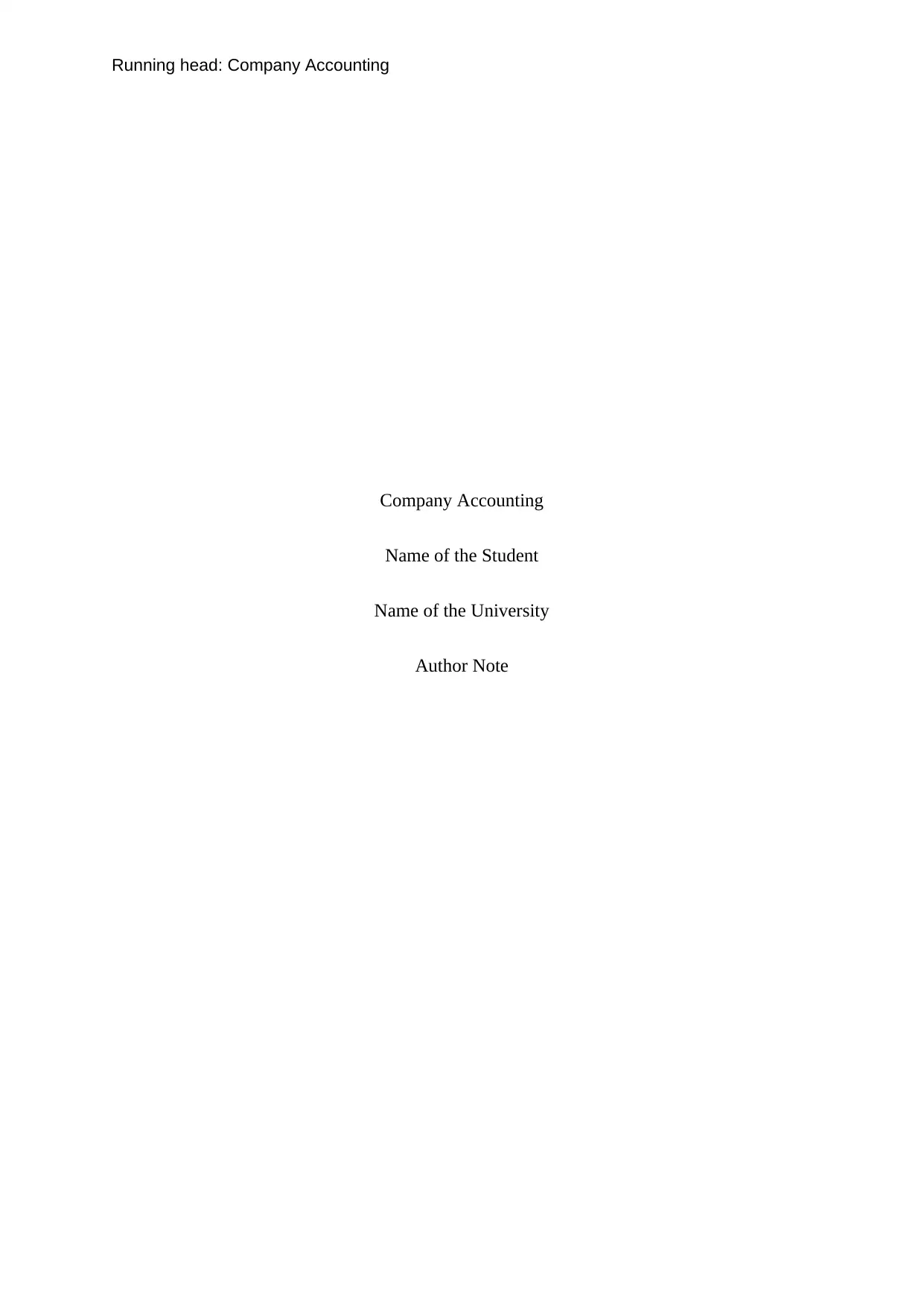
Running head: Company Accounting
Company Accounting
Name of the Student
Name of the University
Author Note
Company Accounting
Name of the Student
Name of the University
Author Note
Paraphrase This Document
Need a fresh take? Get an instant paraphrase of this document with our AI Paraphraser
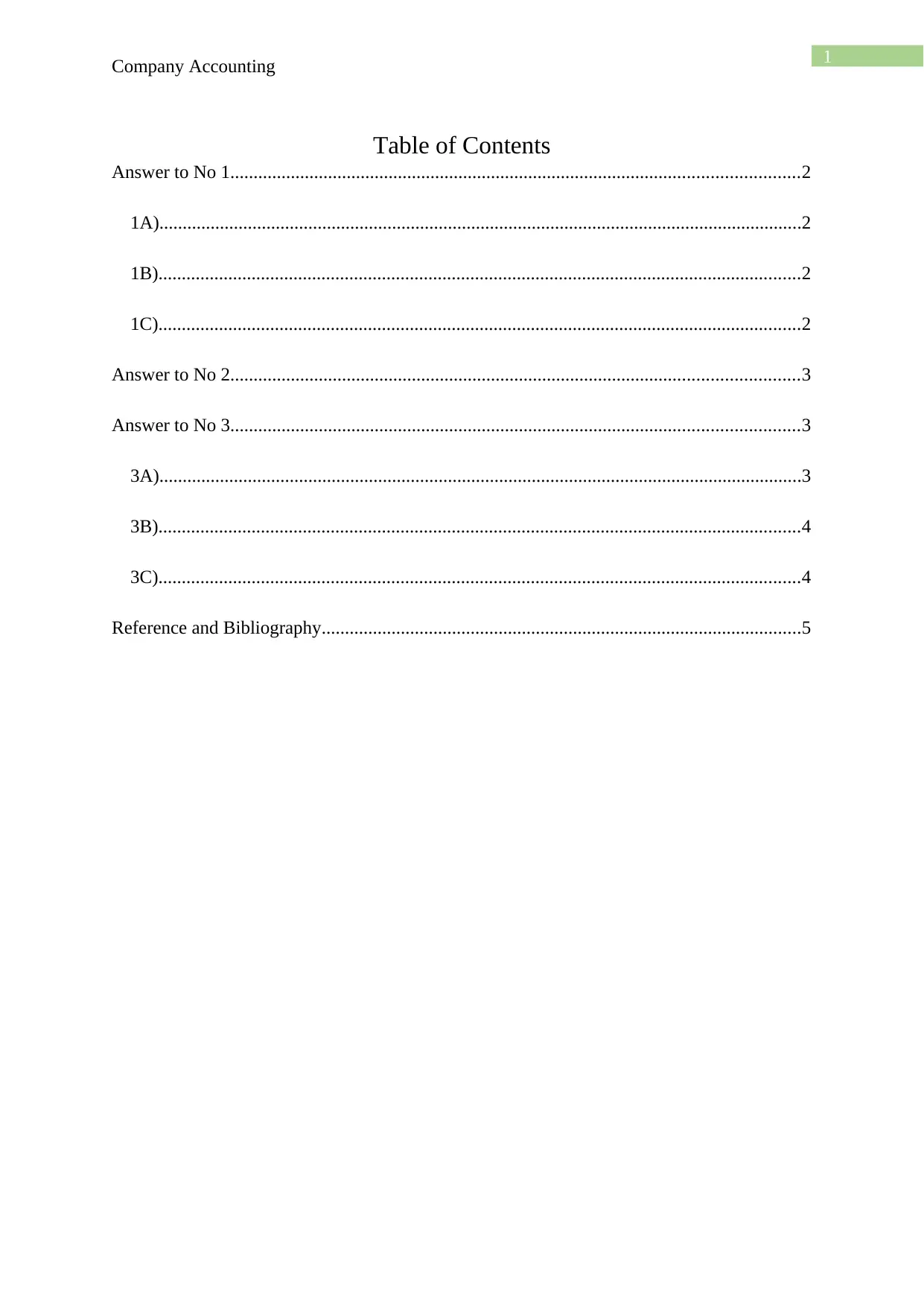
1
Company Accounting
Table of Contents
Answer to No 1..........................................................................................................................2
1A)..........................................................................................................................................2
1B)..........................................................................................................................................2
1C)..........................................................................................................................................2
Answer to No 2..........................................................................................................................3
Answer to No 3..........................................................................................................................3
3A)..........................................................................................................................................3
3B)..........................................................................................................................................4
3C)..........................................................................................................................................4
Reference and Bibliography.......................................................................................................5
Company Accounting
Table of Contents
Answer to No 1..........................................................................................................................2
1A)..........................................................................................................................................2
1B)..........................................................................................................................................2
1C)..........................................................................................................................................2
Answer to No 2..........................................................................................................................3
Answer to No 3..........................................................................................................................3
3A)..........................................................................................................................................3
3B)..........................................................................................................................................4
3C)..........................................................................................................................................4
Reference and Bibliography.......................................................................................................5
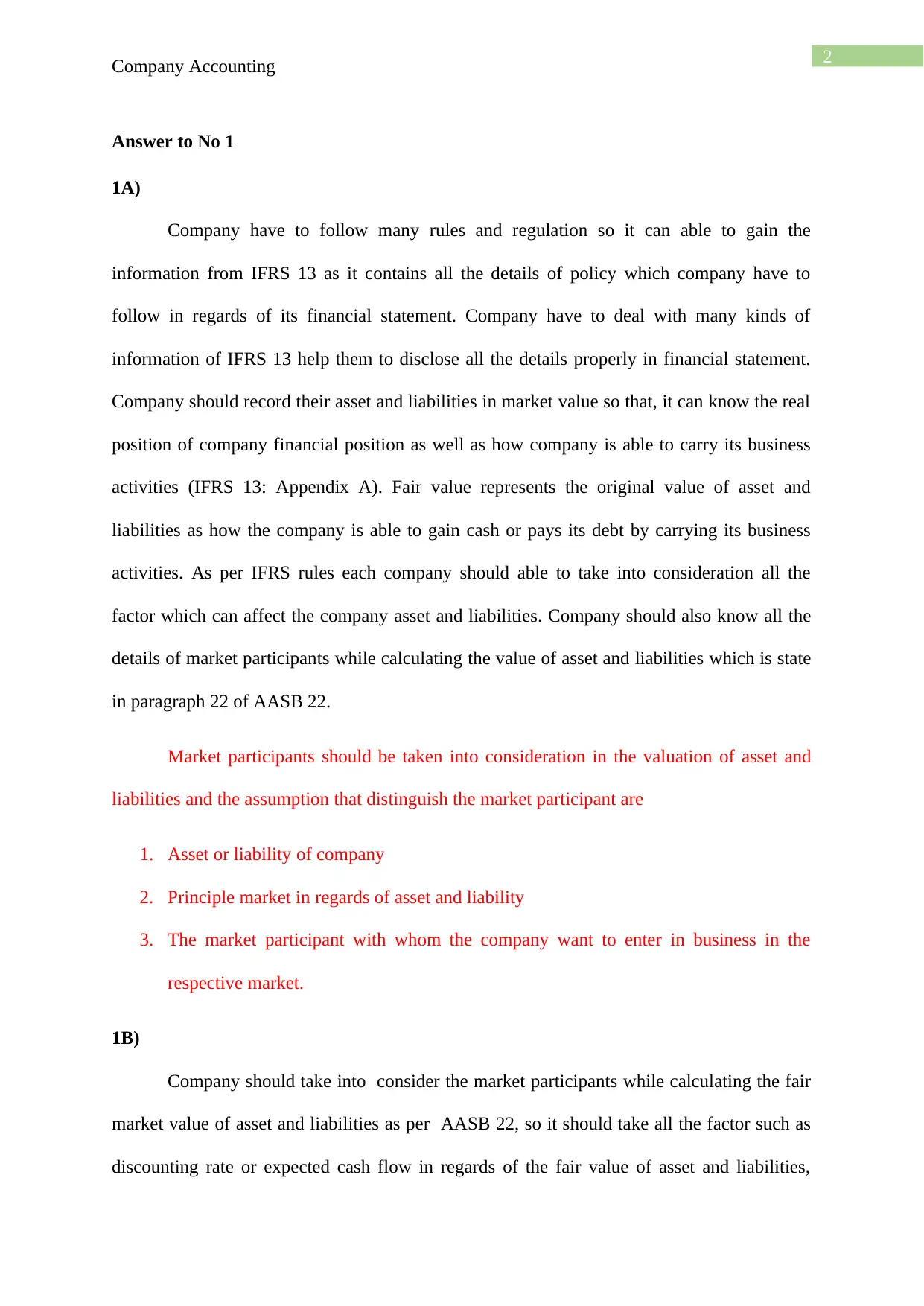
2
Company Accounting
Answer to No 1
1A)
Company have to follow many rules and regulation so it can able to gain the
information from IFRS 13 as it contains all the details of policy which company have to
follow in regards of its financial statement. Company have to deal with many kinds of
information of IFRS 13 help them to disclose all the details properly in financial statement.
Company should record their asset and liabilities in market value so that, it can know the real
position of company financial position as well as how company is able to carry its business
activities (IFRS 13: Appendix A). Fair value represents the original value of asset and
liabilities as how the company is able to gain cash or pays its debt by carrying its business
activities. As per IFRS rules each company should able to take into consideration all the
factor which can affect the company asset and liabilities. Company should also know all the
details of market participants while calculating the value of asset and liabilities which is state
in paragraph 22 of AASB 22.
Market participants should be taken into consideration in the valuation of asset and
liabilities and the assumption that distinguish the market participant are
1. Asset or liability of company
2. Principle market in regards of asset and liability
3. The market participant with whom the company want to enter in business in the
respective market.
1B)
Company should take into consider the market participants while calculating the fair
market value of asset and liabilities as per AASB 22, so it should take all the factor such as
discounting rate or expected cash flow in regards of the fair value of asset and liabilities,
Company Accounting
Answer to No 1
1A)
Company have to follow many rules and regulation so it can able to gain the
information from IFRS 13 as it contains all the details of policy which company have to
follow in regards of its financial statement. Company have to deal with many kinds of
information of IFRS 13 help them to disclose all the details properly in financial statement.
Company should record their asset and liabilities in market value so that, it can know the real
position of company financial position as well as how company is able to carry its business
activities (IFRS 13: Appendix A). Fair value represents the original value of asset and
liabilities as how the company is able to gain cash or pays its debt by carrying its business
activities. As per IFRS rules each company should able to take into consideration all the
factor which can affect the company asset and liabilities. Company should also know all the
details of market participants while calculating the value of asset and liabilities which is state
in paragraph 22 of AASB 22.
Market participants should be taken into consideration in the valuation of asset and
liabilities and the assumption that distinguish the market participant are
1. Asset or liability of company
2. Principle market in regards of asset and liability
3. The market participant with whom the company want to enter in business in the
respective market.
1B)
Company should take into consider the market participants while calculating the fair
market value of asset and liabilities as per AASB 22, so it should take all the factor such as
discounting rate or expected cash flow in regards of the fair value of asset and liabilities,
⊘ This is a preview!⊘
Do you want full access?
Subscribe today to unlock all pages.

Trusted by 1+ million students worldwide
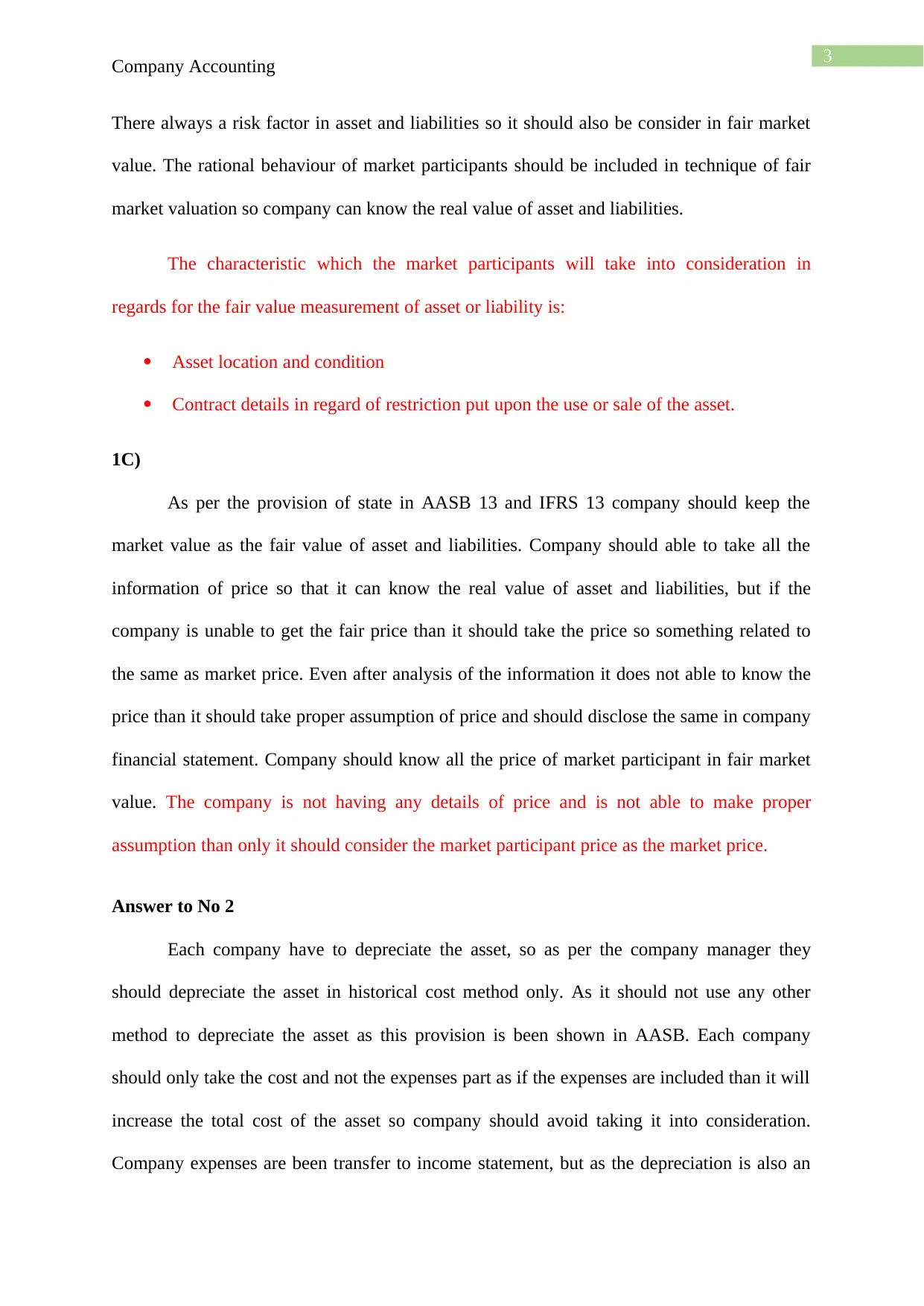
3
Company Accounting
There always a risk factor in asset and liabilities so it should also be consider in fair market
value. The rational behaviour of market participants should be included in technique of fair
market valuation so company can know the real value of asset and liabilities.
The characteristic which the market participants will take into consideration in
regards for the fair value measurement of asset or liability is:
Asset location and condition
Contract details in regard of restriction put upon the use or sale of the asset.
1C)
As per the provision of state in AASB 13 and IFRS 13 company should keep the
market value as the fair value of asset and liabilities. Company should able to take all the
information of price so that it can know the real value of asset and liabilities, but if the
company is unable to get the fair price than it should take the price so something related to
the same as market price. Even after analysis of the information it does not able to know the
price than it should take proper assumption of price and should disclose the same in company
financial statement. Company should know all the price of market participant in fair market
value. The company is not having any details of price and is not able to make proper
assumption than only it should consider the market participant price as the market price.
Answer to No 2
Each company have to depreciate the asset, so as per the company manager they
should depreciate the asset in historical cost method only. As it should not use any other
method to depreciate the asset as this provision is been shown in AASB. Each company
should only take the cost and not the expenses part as if the expenses are included than it will
increase the total cost of the asset so company should avoid taking it into consideration.
Company expenses are been transfer to income statement, but as the depreciation is also an
Company Accounting
There always a risk factor in asset and liabilities so it should also be consider in fair market
value. The rational behaviour of market participants should be included in technique of fair
market valuation so company can know the real value of asset and liabilities.
The characteristic which the market participants will take into consideration in
regards for the fair value measurement of asset or liability is:
Asset location and condition
Contract details in regard of restriction put upon the use or sale of the asset.
1C)
As per the provision of state in AASB 13 and IFRS 13 company should keep the
market value as the fair value of asset and liabilities. Company should able to take all the
information of price so that it can know the real value of asset and liabilities, but if the
company is unable to get the fair price than it should take the price so something related to
the same as market price. Even after analysis of the information it does not able to know the
price than it should take proper assumption of price and should disclose the same in company
financial statement. Company should know all the price of market participant in fair market
value. The company is not having any details of price and is not able to make proper
assumption than only it should consider the market participant price as the market price.
Answer to No 2
Each company have to depreciate the asset, so as per the company manager they
should depreciate the asset in historical cost method only. As it should not use any other
method to depreciate the asset as this provision is been shown in AASB. Each company
should only take the cost and not the expenses part as if the expenses are included than it will
increase the total cost of the asset so company should avoid taking it into consideration.
Company expenses are been transfer to income statement, but as the depreciation is also an
Paraphrase This Document
Need a fresh take? Get an instant paraphrase of this document with our AI Paraphraser
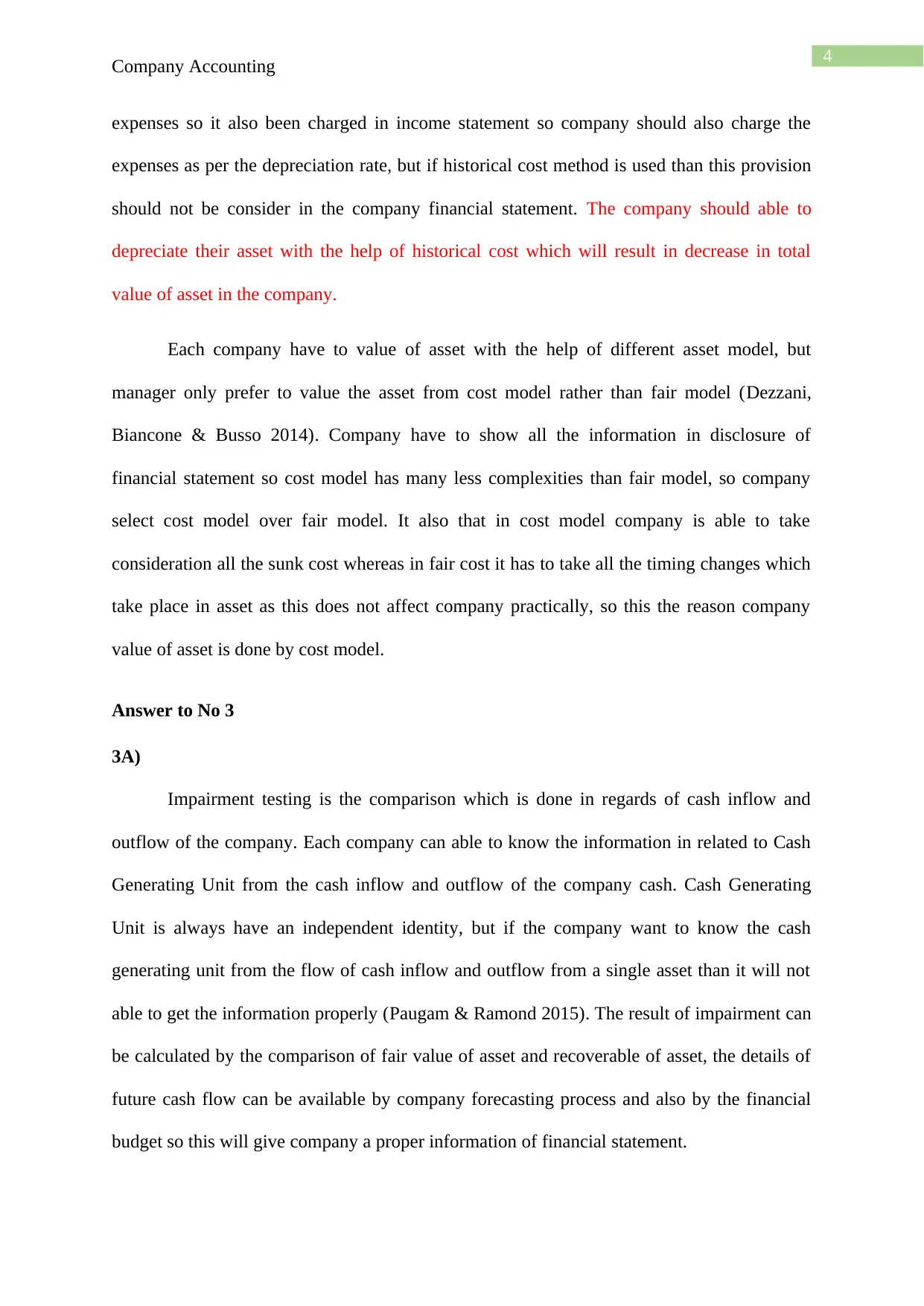
4
Company Accounting
expenses so it also been charged in income statement so company should also charge the
expenses as per the depreciation rate, but if historical cost method is used than this provision
should not be consider in the company financial statement. The company should able to
depreciate their asset with the help of historical cost which will result in decrease in total
value of asset in the company.
Each company have to value of asset with the help of different asset model, but
manager only prefer to value the asset from cost model rather than fair model (Dezzani,
Biancone & Busso 2014). Company have to show all the information in disclosure of
financial statement so cost model has many less complexities than fair model, so company
select cost model over fair model. It also that in cost model company is able to take
consideration all the sunk cost whereas in fair cost it has to take all the timing changes which
take place in asset as this does not affect company practically, so this the reason company
value of asset is done by cost model.
Answer to No 3
3A)
Impairment testing is the comparison which is done in regards of cash inflow and
outflow of the company. Each company can able to know the information in related to Cash
Generating Unit from the cash inflow and outflow of the company cash. Cash Generating
Unit is always have an independent identity, but if the company want to know the cash
generating unit from the flow of cash inflow and outflow from a single asset than it will not
able to get the information properly (Paugam & Ramond 2015). The result of impairment can
be calculated by the comparison of fair value of asset and recoverable of asset, the details of
future cash flow can be available by company forecasting process and also by the financial
budget so this will give company a proper information of financial statement.
Company Accounting
expenses so it also been charged in income statement so company should also charge the
expenses as per the depreciation rate, but if historical cost method is used than this provision
should not be consider in the company financial statement. The company should able to
depreciate their asset with the help of historical cost which will result in decrease in total
value of asset in the company.
Each company have to value of asset with the help of different asset model, but
manager only prefer to value the asset from cost model rather than fair model (Dezzani,
Biancone & Busso 2014). Company have to show all the information in disclosure of
financial statement so cost model has many less complexities than fair model, so company
select cost model over fair model. It also that in cost model company is able to take
consideration all the sunk cost whereas in fair cost it has to take all the timing changes which
take place in asset as this does not affect company practically, so this the reason company
value of asset is done by cost model.
Answer to No 3
3A)
Impairment testing is the comparison which is done in regards of cash inflow and
outflow of the company. Each company can able to know the information in related to Cash
Generating Unit from the cash inflow and outflow of the company cash. Cash Generating
Unit is always have an independent identity, but if the company want to know the cash
generating unit from the flow of cash inflow and outflow from a single asset than it will not
able to get the information properly (Paugam & Ramond 2015). The result of impairment can
be calculated by the comparison of fair value of asset and recoverable of asset, the details of
future cash flow can be available by company forecasting process and also by the financial
budget so this will give company a proper information of financial statement.

5
Company Accounting
3B)
The details of independency of cash flow can be obtained by company from the
computation of Cash Generating Unit. In the case study it can see that each driver take a
specific route in the business, so as each driver is taking different route to reach the
destination so it will be easy for the company to know the independency of cash flow from
the same. Saferide Bus company should consider the bus, driver and route in order to
compute the cash generating unit of the business.
3C)
Saferide Bus Company can able to know the amount of net cash for each route as it
can be calculated but if the company want to know the cash flow in regards of each bus than
it is not possible for the company to calculate the independency of cash flow from the same.
Company Accounting
3B)
The details of independency of cash flow can be obtained by company from the
computation of Cash Generating Unit. In the case study it can see that each driver take a
specific route in the business, so as each driver is taking different route to reach the
destination so it will be easy for the company to know the independency of cash flow from
the same. Saferide Bus company should consider the bus, driver and route in order to
compute the cash generating unit of the business.
3C)
Saferide Bus Company can able to know the amount of net cash for each route as it
can be calculated but if the company want to know the cash flow in regards of each bus than
it is not possible for the company to calculate the independency of cash flow from the same.
⊘ This is a preview!⊘
Do you want full access?
Subscribe today to unlock all pages.

Trusted by 1+ million students worldwide
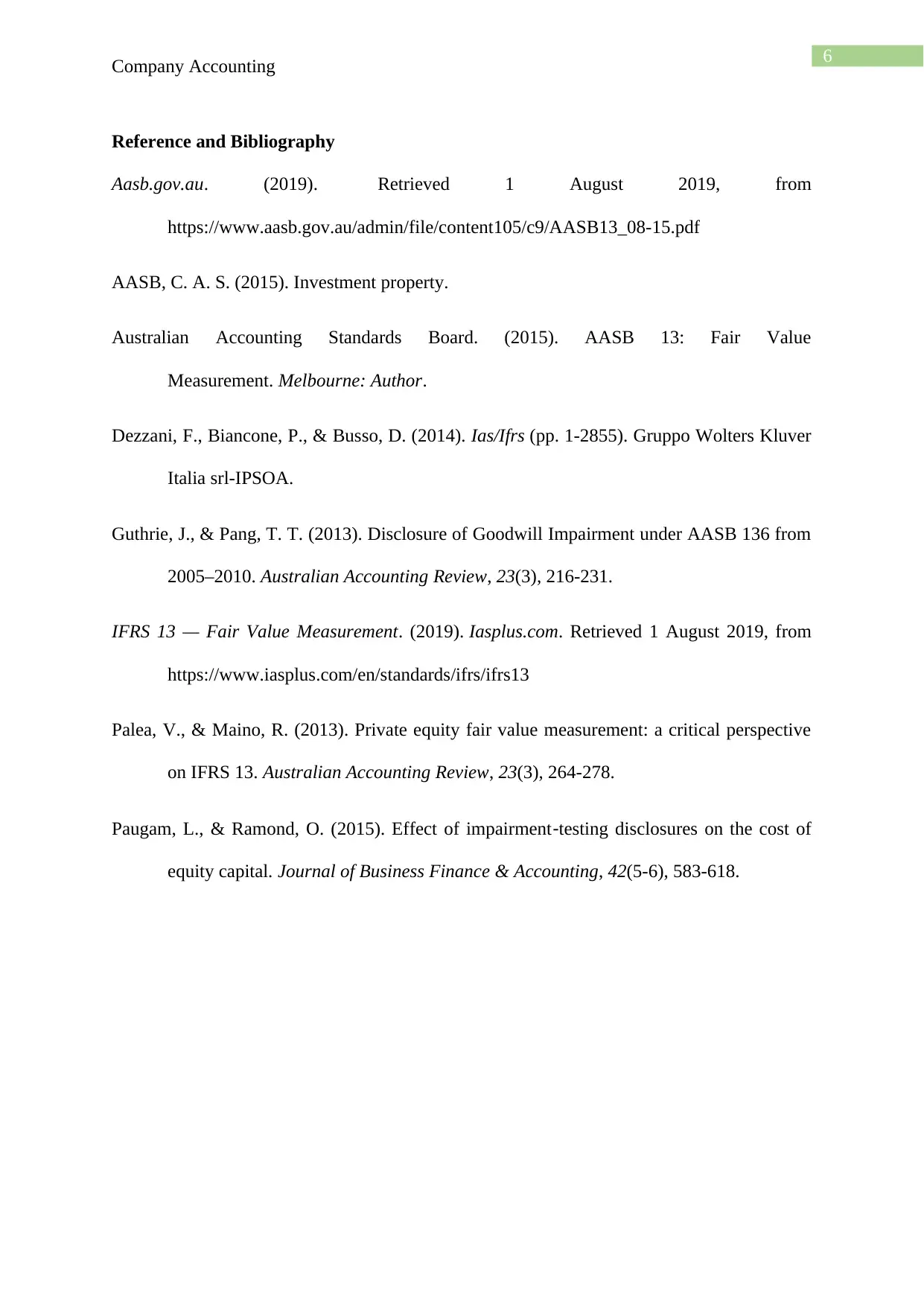
6
Company Accounting
Reference and Bibliography
Aasb.gov.au. (2019). Retrieved 1 August 2019, from
https://www.aasb.gov.au/admin/file/content105/c9/AASB13_08-15.pdf
AASB, C. A. S. (2015). Investment property.
Australian Accounting Standards Board. (2015). AASB 13: Fair Value
Measurement. Melbourne: Author.
Dezzani, F., Biancone, P., & Busso, D. (2014). Ias/Ifrs (pp. 1-2855). Gruppo Wolters Kluver
Italia srl-IPSOA.
Guthrie, J., & Pang, T. T. (2013). Disclosure of Goodwill Impairment under AASB 136 from
2005–2010. Australian Accounting Review, 23(3), 216-231.
IFRS 13 — Fair Value Measurement. (2019). Iasplus.com. Retrieved 1 August 2019, from
https://www.iasplus.com/en/standards/ifrs/ifrs13
Palea, V., & Maino, R. (2013). Private equity fair value measurement: a critical perspective
on IFRS 13. Australian Accounting Review, 23(3), 264-278.
Paugam, L., & Ramond, O. (2015). Effect of impairment‐testing disclosures on the cost of
equity capital. Journal of Business Finance & Accounting, 42(5-6), 583-618.
Company Accounting
Reference and Bibliography
Aasb.gov.au. (2019). Retrieved 1 August 2019, from
https://www.aasb.gov.au/admin/file/content105/c9/AASB13_08-15.pdf
AASB, C. A. S. (2015). Investment property.
Australian Accounting Standards Board. (2015). AASB 13: Fair Value
Measurement. Melbourne: Author.
Dezzani, F., Biancone, P., & Busso, D. (2014). Ias/Ifrs (pp. 1-2855). Gruppo Wolters Kluver
Italia srl-IPSOA.
Guthrie, J., & Pang, T. T. (2013). Disclosure of Goodwill Impairment under AASB 136 from
2005–2010. Australian Accounting Review, 23(3), 216-231.
IFRS 13 — Fair Value Measurement. (2019). Iasplus.com. Retrieved 1 August 2019, from
https://www.iasplus.com/en/standards/ifrs/ifrs13
Palea, V., & Maino, R. (2013). Private equity fair value measurement: a critical perspective
on IFRS 13. Australian Accounting Review, 23(3), 264-278.
Paugam, L., & Ramond, O. (2015). Effect of impairment‐testing disclosures on the cost of
equity capital. Journal of Business Finance & Accounting, 42(5-6), 583-618.
1 out of 7
Related Documents
Your All-in-One AI-Powered Toolkit for Academic Success.
+13062052269
info@desklib.com
Available 24*7 on WhatsApp / Email
![[object Object]](/_next/static/media/star-bottom.7253800d.svg)
Unlock your academic potential
Copyright © 2020–2025 A2Z Services. All Rights Reserved. Developed and managed by ZUCOL.





